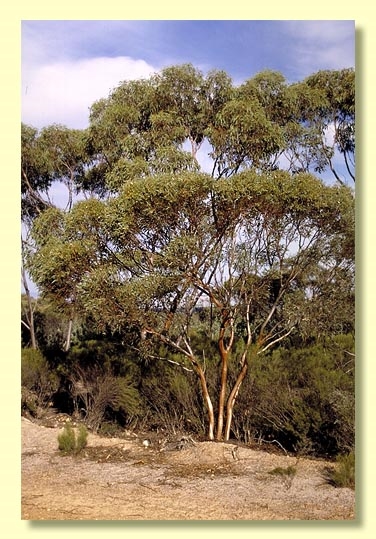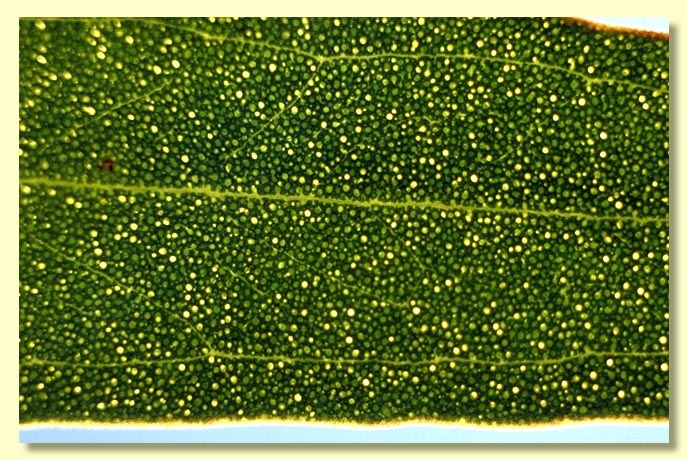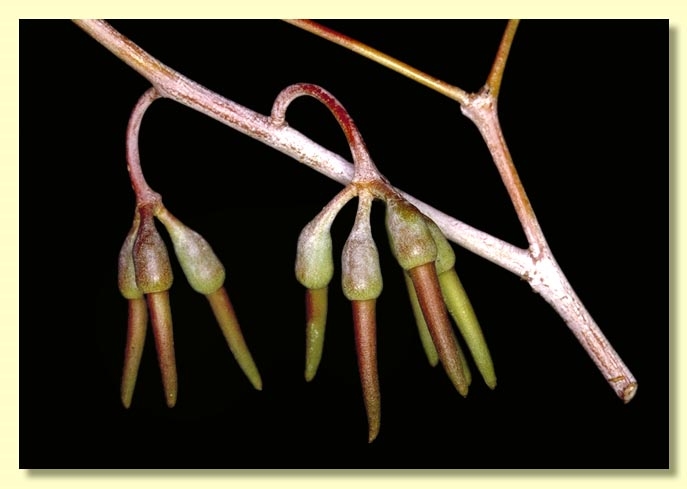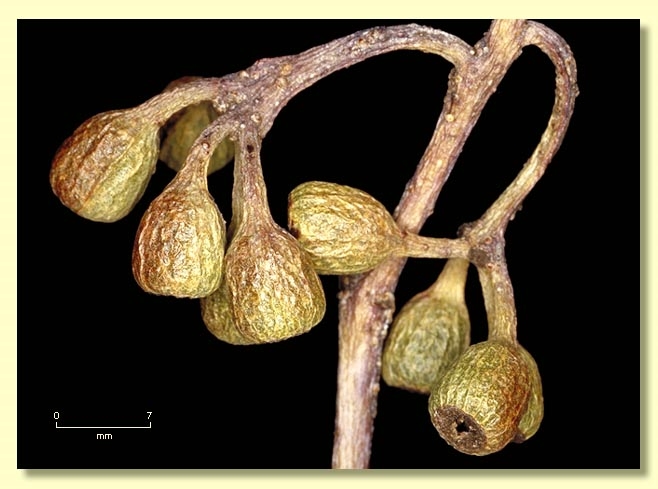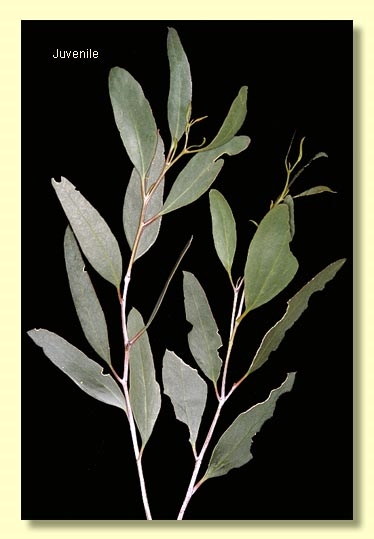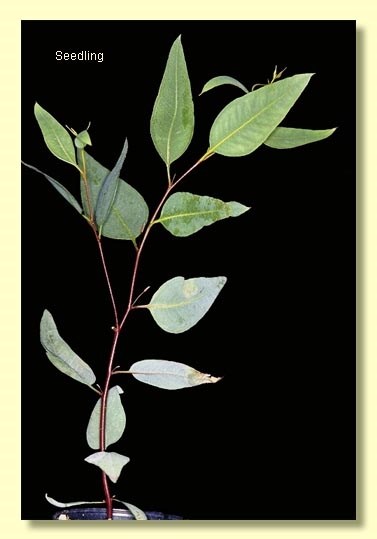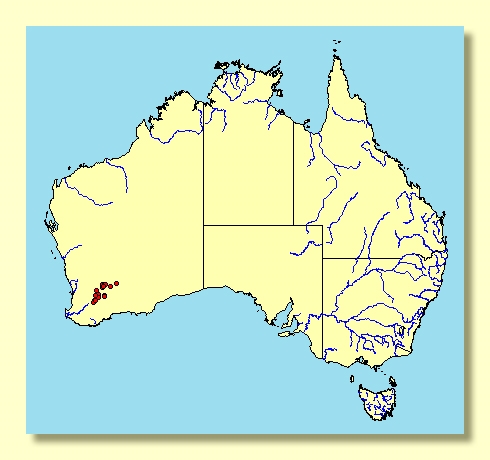Eucalyptus | Symphyomyrtus | Bisectae | Glandulosae | Erectae | Abundae
Euclid - Online edition
Eucalyptus tephroclada
T: Western Australia: 6 km from Bruce Rock on Narembeen road, 15 Nov. 1986, K.D.Hill 2484, L.A.S.Johnson & D.F.Blaxell; holo: NSW; iso: PERTH.
[Eucalyptus erythronema Turcz. var. roei Beck & Maiden, Crit. Revis. Eucalyptus 1: 110 (1904); in syn., nom. nud.; in part.]
Bark smooth throughout, rich coppery red and silvery brown to pale grey.
Branchlets glaucous; oil glands present in the pith.
Juvenile growth (coppice or field seedlings to 50 cm): stems rounded in cross-section, glaucous; juvenile leaves always petiolate, opposite at lowest node only then alternate, elliptical to lanceolate or narrowly ovate, 3–9 cm long, 1.5–3.5 cm wide, slightly glaucous weathering to grey-green.
Adult leaves alternate, petioles 0.7–2 cm long; blade lanceolate, 5–10 cm long, (0.6)0.9–1.5 cm wide, base tapering to petiole, margin entire, apex pointed, concolorous, initially slightly glaucous weathering to non-glaucous glossy green, surface appearing "glazed", side-veins acute or obscure, reticulation obscure, intramarginal vein present or obscure, oil glands numerous, island.
Inflorescence pendulous, axillary unbranched, peduncles glaucous, slender, flattened, widening apically, 1.2–4 cm long, buds (?7)9, 11, 13, pedicellate (pedicels 0.5–1.1 cm long). Mature buds elongated and widest below the join, (2.4–3.2 cm long, 0.5–0.8 cm wide), glaucous at least basally, scar present (outer operculum shed early), operculum horn-shaped, ca 2.5–4 times the length of the hypanthium, stamens erect, anthers oblong, versatile, dorsifixed, dehiscing by longitudinal slits, style long and straight, stigma blunt to slightly dilated, locules 4(5), the placentae each with 4 vertical rows of ovules. Flowers pale lemon-yellow.
Fruit down-turned, pedicellate (pedicels 0.4–1.2 cm long), stoutly barrel-shaped to cupular, 0.8–1.4 cm long, 0.6–1 cm wide, disc obscured by persistent staminophore, valves 4(5), tips at about rim level.
Seeds dark brown, 0.7–2 mm long, ovoid to flattened-ovoid, dorsal surface clearly and shallowly reticulate, hilum ventral.
Cultivated seedlings (measured at node 10): cotyledons Y-shaped (bisected); stems rounded in cross-section, glaucous or non-glaucous; leaves always petiolate, opposite for 3 or 4 nodes then alternate, ovate to lanceolate, 6–8.5 cm long, 2–3.5 cm wide, dull, grey-green to green.
Flowering has been recorded in February, October, November and December.
A mallee endemic to Western Australia, occurring in the southern wheatbelt, particularly in the area bounded by Quairading, Southern Cross, Kukerin and Hyden. The stems are smooth-barked, branchlets and buds white waxy, and the adult leaves glossy, green.
Eucalyptus tephroclada belongs in Eucalyptus subgenus Symphyomyrtus section Bisectae subsection Glandulosae because the buds have an operculum scar, cotyledons are bisected and branchlets have oil glands in the pith. Within this large subsection (ca 80 species), E. tephroclada is closely related to a group of mallees and mallets (series Erectae subseries Abundae, 14 species) recognised by the glazed leaf surface, leaves with a great density of oil glands that obscures the venation, peduncles long and flattened, inflorescences spreading to pendulous and buds with a long operculum and erect stamens.
The 14 species in subseries Abundae are loosely grouped as follows. There are five species here considered to form the E. eremophila group—E. depauperata, E. eremophila, E. incerata, E. tenera and E. tephroclada. All have non-ridged buds and fruit, which separates them from E. goniocarpa, E. platypus, E. utilis, E. mimica, E. steedmanii and E. alipes. E. suggrandis, whilst weakly or non-ridged, has much smaller buds with +/- warty opercula. E. spathulata and E. orthostemon also have non-ridged buds that are quite small, as well as very narrowly linear leaves.
The five species in the E. eremophila group are segregated by size of buds and fruit, and presence and absence of white wax on stems, leaves, buds and fruit.
The white waxy E. tephroclada and the non-waxy E. tenera are very similar in all features except this waxiness, and in their respective distributions. Both species have smaller buds and fruits than the non-waxy mallet E. eremophila and waxy mallee E. incerata.
The fifth species in the group, E. depauperata, is a slender non-waxy whipstick mallee "distinguished within the E. eremophila group by the small leaves, buds and fruits" (Hill & Johnson, 1991), which, even at its type locality south-east of Lake King, grows with plants that have larger buds and look more like E. tenera.
Whilst the five species that now make up the E. eremophila group are included in this edition of EUCLID it is not always possible to assign individual plants to one or other of the names with certainty.

